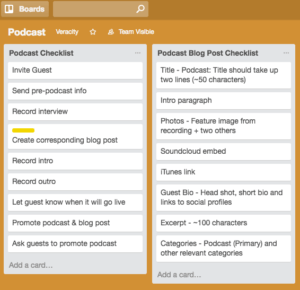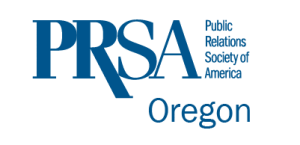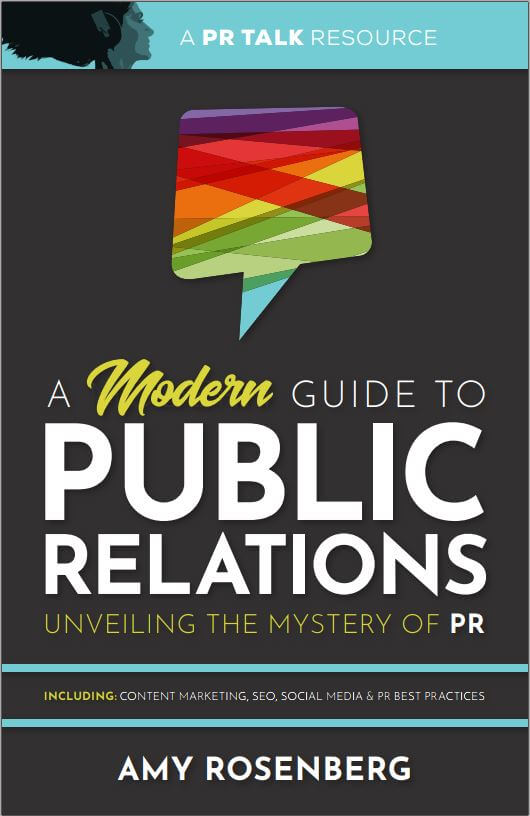![Cision’s Rebecca Dersh [Podcast]](https://www.veracityagency.com/wp-content/uploads/Rebecca-Dersh-on-PR-Talk.jpg)
by Josh Friesen | Sep 11, 2019 | Podcast, Public Relations
Bringing PR into the Digital Age with Cision’s Rebecca Dersh
If you’re a PR pro, you’ve probably already used Cision to pull media lists. However, as Amy found out in this interview with Rebecca Dersh — Public Relations Manager for Cision — the platform can do so much more.
As Rebecca describes it, Cision is a software solution helping PR and communication pros reach, target, and engage their audience. During the course of Amy and Rebecca’s chat, we discover how tools like Cision can help us justify our activities to our clients and open the door for more strategic work.
PR Reporting is Changing
Everyone in PR should be doing a better job of measuring ROI. In the analog days, that wasn’t always easy, and some industry members remain stuck in that old mindset. Rebecca explained how Cision makes it possible to connect PR activities with direct business results — the same way marketing and advertising can. This ability allows PR pros to showcase how consumers viewed a piece of media coverage and how it generated website visits and purchases.
PR Analytics are Now a Reality
Through their recent acquisition of TrendKite — a PR analytics company — Cision has brought PR reporting in line with ad and marketing tech. Now, PR pros can sync Cision up with their client’s Google Analytics and use the resulting information to place their efforts in context and tell better stories.
Rebecca believes these new capabilities also open the door for greater integration between earned media teams and their advertising and marketing colleagues. For example, how can paid media pros use earned media analytics to repurpose and retarget their paid media opportunities?
Will Automation Steal Our Jobs?
As their conversation progressed, Amy broached the subject of PR automation. Cision can automate tasks like updating media lists, ed calendar tracking, delivery and reporting. So, is PR ever at risk of becoming fully automated?
While Amy and Rebecca both agreed that the creativity and strategic thinking necessary for successful PR could never truly be automated, using tools like Cision to their fullest can make the average PR pro more successful. Ideally, most of our time should be spent thinking strategically to craft the best pitch possible. Instead, we often get bogged down in other time-consuming tasks that could otherwise be automated. So we might as well use technology to free up a little extra bit of space in our brains, and in turn, do better work.
Wait, There’s More!
Listen to the podcast to hear more of Amy and Rebecca’s conversation about emerging PR technology, and to hear what it’s like for Rebecca to do PR for PR. You can also subscribe to the PR Talk Podcast on Stitcher, iTunes, and Google Play.
About the guest: Rebecca Dersh
After earning her B.A. at American University, Rebecca Dersh began her career with global branding agency Wolff Olins. While there, she worked with a wide variety of clients from nonprofit to tech, before leaving New York for Austin, Texas. Today she works for Cision as its Public Relations Manager.
Connect and follow Rebecca on social media:
This episode of PR Talk is brought to you by PRSA Oregon
Throughout Oregon and Southwest Washington, PRSA provides members with networking, mentorship, skill building and professional development opportunities – whether you are a new professional fresh out of college or a skilled expert with 20 years in the industry. Check out PRSAoregon.org for more information on how membership can help you grow and connect.
![PR Tools [Podcast]](https://www.veracityagency.com/wp-content/uploads/PR-Tools-800x600-1.jpg)
by Mike Rosenberg | Jul 10, 2019 | Podcast, Public Relations
PR Tools
If you are like me and you hear the term tools, you start thinking about software or applications that make your job easier. Or, maybe you think about the more classic tools of a carpenter such as a hammer, measuring tape and architectural designs? Others may think of humans most important tool, the mind.
In this episode of PR Talk, Amy shares her view that the most important PR Tool is not the mind, relationships, a press release or even her favorite, the telephone. She insists that the most important PR tool is instinct.
Other PR tools that help you do your job include:
- The Press Pitch
- Editorial Calendars
- Contributed Articles & Ghostwriting
- Media Exclusives
- Additional (maybe even more important) tools
- Photos & Videos
- Media Database/Media List/Relationships
- Press Kits & Virtual Press Rooms
- Media Drops
- Email
- Snail Mail
- The Telephone
This episode of PR Talk is brought to you by PRSA Oregon
Throughout Oregon and Southwest Washington, PRSA provides members with networking, mentorship, skill building and professional development opportunities – whether you are a new professional fresh out of college or a skilled expert with 20 years in the industry. Check out PRSAoregon.org for more information on how membership can help you grow and connect.

by Connor Laubenstein | Apr 5, 2017 | General, Posts
As we begin to shed our winter coats and dust off the cobwebs in preparation for the revitalization of spring, it’s always refreshing to do a little tidying up. The cold months bog us down with clutter — both in our physical spaces and our minds. So when the sun returns, seemingly having flown south for the winter, we doff the extra weight and hit the grass running.
There’s no reason not to apply this newly found energy it to your workspace too. So break out the Windex, everyone, here’s some advice on how to de-clutter for springtime and increase productivity on the job.
Start with what’s in front of you.
This means your desk, cubicle, office — whatever you call home when you’re at work, you should make the effort to respect as such. After all, you spend a sizable chunk of time there, you might as well be comfortable! Dust off your computer monitor. Get that lumbar support in order. Maybe it’s time to throw away those coffee cups and parking stubs. Get a new air purifying plant for your desk (I’m in the market for an Aloe vera plant — they keep easy and I’m not going to pretend that I don’t sunburn.) Take an hour to dig into your space — you’ll appreciate it once it’s done.
Assess what’s on your plate.
Work down the list of all the ambitious projects you’ve been wanting to do since August, but have been putting off to get other, more immediate work done. Cull that list down to initiatives you actually think you will accomplish, not the pipe dreams. Set aside a half, or even a whole, day to knock some of the easier projects off your list for good. If there are still items that you want to keep on the back-burner for a rainy (or snowy) day, see my notes below about project organizational tools.
Monitor your recent performance.
Tools like Toggl, a time tracking application, can tell a lot about how and where you’re spending your energy and what you could focus on more diligently. Whether you work for an agency, billing hours to many clients, or you’re in-house and want to track the time you spend on different projects, Toggl sends you weekly reports that show the concentration of your efforts. The company is releasing an insights feature soon, in an attempt to economize employee productivity.
Set some goals.
I’m a huge advocate for generating and documenting tangible goals. If you’re results-driven, like me, then you know how good it feels to check something off your list and know that it’s done. This is why the tangibility of your goals is so important — goals like “get better at responding to emails,” or “write more often,” are nebulous and you’ll never really know if you’ve achieved them. Of course you can strive towards those vague goals, but additionally, write down a few actionable, quantifiable items that you can definitively check off.
Try out new tools.

Part of a Trello board for our podcast, ChalkTalk.
I’ve already thrown in a plug for Toggl, so I might as well keep it going. We use Trello as a project management tool to keep our team in the loop. Each client gets their own page (Trello calls it a board) and we make a to-do list for every campaign running for that client. You can comment and communicate within the lists, updating the team on the status of the campaign. If your inbox is already gasping for air, giving updates in Trello eradicates the need to send minutia via email.
Spring is springing and it’s a great time to take advantage of your renewed energy by doing some cleaning up. Start with your physical space to clear the air so you can focus more deeply on upcoming projects, goal-setting and tools that will make your life easier and more productive.
![Cision’s Rebecca Dersh [Podcast]](https://www.veracityagency.com/wp-content/uploads/Rebecca-Dersh-on-PR-Talk.jpg)


![PR Tools [Podcast]](https://www.veracityagency.com/wp-content/uploads/PR-Tools-800x600-1.jpg)





